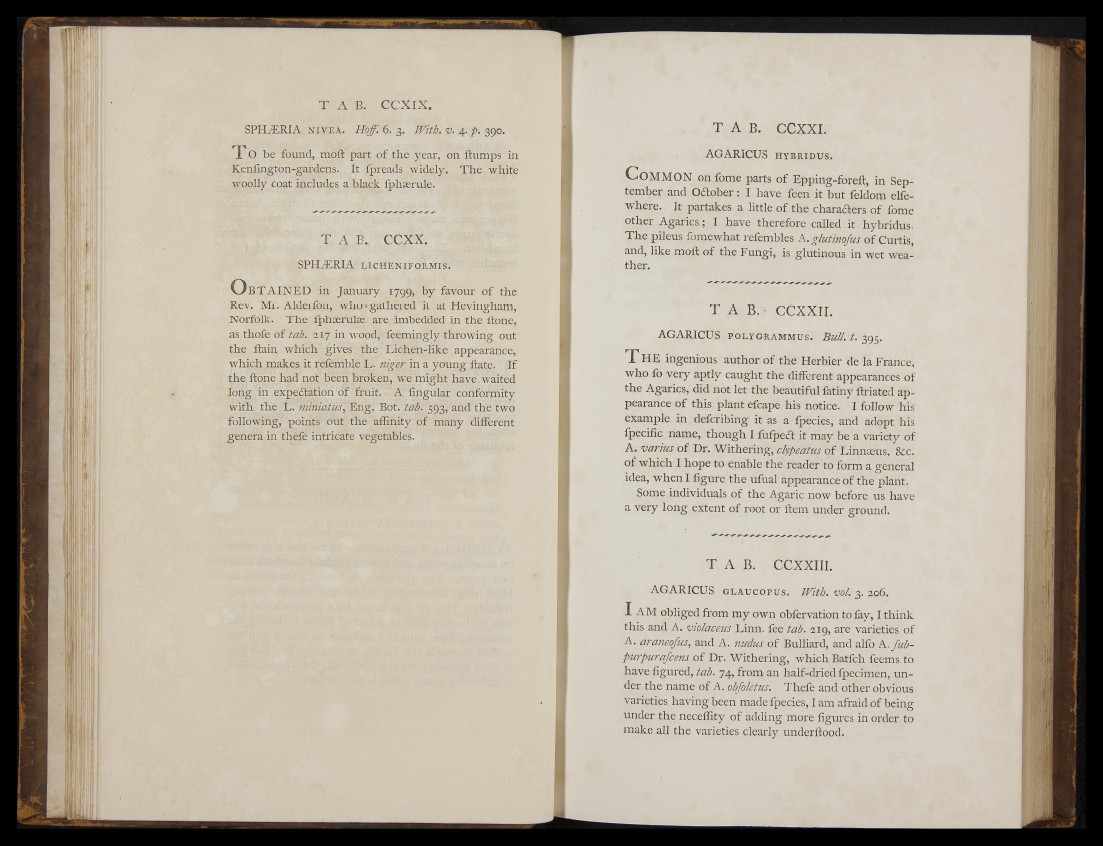
!. 1 »i
liii'' !
il'i
't! I
1-1
: ' I.)'!
Ull '¡i'ff ,
l l i ! 'i!P!fi I
T A B. CCXIX.
SPH^RIA NIVEA. Hoff. 6. 3. mtb. v. 4. p. 390.
be found, moft part of the year, on flumps in
Keniington-gardens. It fpreads widely. The white
woolly coat includes a black fphasrule.
T A B . CCXX.
SPH^RIA LICHENIFORMIS.
'BTAINED in January 1799, by favour of the
Rev. Mr. Alderfon, who • gathered it at Hevingham,
Norfolk. The fphaerulas are imbedded in the ftone,
as thofe of tab. 317 in w^ood, feemingly throwing out
the ftain which gives the Lichen-like appearance,
w^hich makes it refemble L. niger in a young ftate. If
the ftone had not been broken, we might have waited
long in expecStation of fruit. A lingular conformity
with the L. miniatus. Eng. Bot. tab. 593, and the two
following, points out the affinity of many different
genera in thefe intricate vegetables.
• i', M 'i
ili
T A B . CCXXI.
AGARICUS HYBRIDUS.
C o m m o n on fome parts of Epping-foreft, in September
and Odlober: I have feen it but feldom elfewhere.
It partakes a little of the charaders of fome
other Agarics; I have therefore called it hybridus.
The pileus fomewhat refembles Kglutinojus of Curtis,
and, like moft of the Fungi, is glutinous in wet weather.
T A B . CCXXII.
AGARICUS POLYGRAMMUS. Bull. t. 395.
T h e ingenious author of the Herbier de la France,
who fo very aptly caught the different appearances of
the Agarics, did not let the beautiful fatiny ftriated appearance
of this plant efcape his notice. I follow his
example in defcribing it as a fpecies, and adopt his
fpecific name, though I fufpedl it may be a variety of
A. varius of Dr. Withering, clypeatus of Linnaeus, &c.
of which I hope to enable the reader to form a general
idea, when I figure the ufual appearance of the plant.
Some individuals of the Agaric now before us have
a very long extent of root or item under ground.
T A B. CCXXIIL
AGARICUS GLAUCOPUS. With. vol. 3. 206,
I AM obliged from my own obfervation to fay, I think
this and A. violaceus Linn, fee tab. 219, are varieties of
A. araneofus, and A. nudus of Bulliard, and alfo ^.fubpurpurajcens
of Dr. Withering, which Batfch feems to
have figured, tab. 74, from an half-dried fpecimen, under
the name of A. obfoletus. Thefe and other obvious
varieties having been made fpecies, I am afraid of being
under the neceffity of adding more figures in order to
make all the varieties clearly underflood.